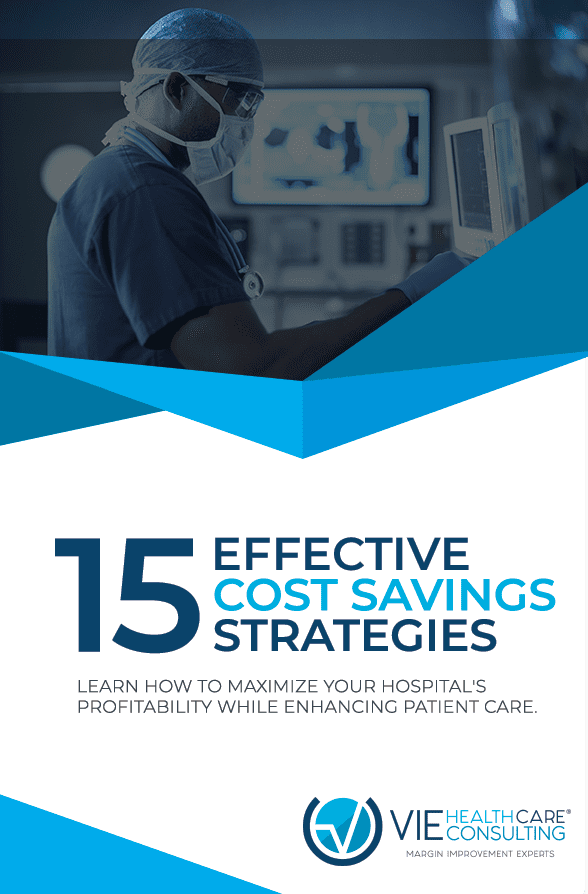6 Emerging Hospital Costs Trends
Have you thought about hospital costs trends in 2022?
There are 6 emerging hospital costs trends you should watch in 2022 and beyond.
The Covid-19 pandemic is undoubtedly the most significant challenge the healthcare system has faced in living memory.
It disrupted the daily lives of Americans and significantly impacted how and where they access healthcare services.
As a result of this shift, medical cost trends were affected in a multitude of ways, including pricing and utilization.
The Health Research Institute (HRI) is projecting a 6.5% medical cost trend in the calendar year 2022.
In this article, we have compiled the most important trends in supply chain and financial improvement opportunities within hospitals.
Let’s dive in.
1. Hospital Costs Trends show the COVID-19 pandemic is no longer the biggest threat hospitals are dealing with. Staffing is.
Staffing is the make-or-break issue for the nursing profession in many countries.
While it is true that COVID-19 has forever altered the nursing landscape, it is safe to say that the nursing profession was facing challenges long before the pandemic.
Here are some facts:
- Over the past 15 years, the registered nurse (RN) workforce was challenged by a national nursing shortage that exceeded 100,000 RNs, two economic recessions, and the implementation of health reforms beginning in 2010 (Nursing Economics);
- A 2017 survey conducted by Kronos found that 63% of registered nurses employed in hospitals have experienced burnout;
- An April survey of 3,500 nurses conducted by Nursing Times shows that almost all nursing staff are feeling more stressed and anxious than usual, with a third describing the state of their mental health as “bad.”
Many nurses leave their job due to factors such as lack of administrative support, an unhealthy work environment, and inadequate staffing, all of which can be frustrating barriers to providing effective care for patients.
It is not uncommon to see hospitals competing to hire nurses while neglecting incentives that can contribute to their retention. This includes opportunities for professional development and a voice in the decisions that affect their work.
Why is this so important?
Truth is, when people leave an organization, you’re not just losing them. You’re losing the experience they have.
Bringing on new resources can be an uphill task because even if you do, you don’t really have, in some instances, all the necessary requirements you need for the organization.
A few days ago, we heard from one of our clients that they were looking for international help for their lab employees as they can’t fill positions in the US.
So, this is causing departments and supply chains that have cost savings and financial budgets and strategic initiatives to be delayed or not fully optimized, which is worst because they’re not getting the full value.
Another issue is that whenever it seems like there’s a nurse shortage, hospitals look to identify quick and efficient ways to onboard new nurses. They seem to ignore that it’s a timely process. They don’t realize that finding the best candidates will take a lot of time and resources.
2. COVID-19 made a pronounced impact on agreements and renewals
COVID-19 has caused a lot of agreements to be pushed out and now they need an extensive review.
We’re seeing hospital costs trends that show hospitals are looking to pull in cost savings in different areas and take in what they can get. Sometimes even knowing that what they’re getting is not fully optimized because they are not getting the best deals or pricing.
It’s interesting to see the shift in agreement, and that’s leading to a lot more renewals coming through.
Case in point: we worked with a hospital that has an organization to provide cardiac rehab sessions. From 2019 to 2020 they had a 50% reduction in their rehab session. But from 2020 to 2021, as COVID-19 progressed, they had an increase in their sessions by 50%.
Matter of fact, when you look at the overall picture, that 50% increase in 2020-2021 shows that you’re down about 25% from the initial impact of COVID-19. Therefore, it’s so important to bring other people into the organization to reduce risks and figure out what the next steps are. Reason being, you have such a large impact upfront and while you think your utilization is increasing, you have to look at the big picture from that perspective.
3. Benchmarking is top-of-mind for hospitals
This is another hospital costs trend that we’re seeing in the marketplace. Hospitals are benchmarking and they get benchmarking reports from the GPOs or different service providers, consultants, RFPs.
Benchmarking is important as it helps you stay abreast of trends in your industry. But with COVID-19, you can’t just look at agreements and benchmark right away. You have to talk to the people in the organization on multiple levels, and then look at the utilization.
One of the biggest trends we’re seeing and hearing from our clients is that a lot of the benchmarking doesn’t always work or isn’t accurate, particularly with companies that just do the benchmark thing. So, this prompts hospitals to utilize 2 or 3 different sources. They run a cross-analysis and are eager to get benchmarking right.
Every contract is different and if you’re not doing the work on a day-to-day basis, you’re not going to know how accurate your benchmark is.
One pro-tip is to compare it to something else and see if it’s accurate. That’s part of the reason why some hospitals use different services because when you compare across the board, you’ll see where some of the gaps are, question those gaps, and then figure out where the opportunity is.
So, for those who might be thinking that buying 2 or 3 different benchmarking solutions is a silly waste of money, you’re missing BIG. It’s an investment well spent because there are different strengths and different benchmarking charges to look at.
For those who might be thinking that buying 2 or 3 different benchmarking solutions is a silly waste of money, you’re missing BIG. Click To TweetBenchmarking is not a one-time event. It’s an ongoing event and a lot of questions need to be answered. You can’t just benchmark directly. You have to get the contract, first. Then you get the end-users involved in the approach and review everything.
On the other hand, you can’t just look at the reports. You have to pull the invoices, match them up with the contract, and ask relevant questions to really understand what’s going on in the historical 12 or 24 months view.
Utilization is becoming a big driver for cost savings although it takes a lot more work (12 to 24 months).
Hospitals take a deep historical and analytical view to create a baseline. They’re getting far different results, far different views, and far different talking points. Then they review their agreement and renegotiate whatever was missing. Sometimes they just take out a few invoices and renegotiate on that, whether it’s for value analysis or to have discussions with physicians.
In a nutshell, make sure you do a deeper review. It’s not just about price matching or service matching. It’s an all-inclusive approach that should take into account rebates and other special promotions.
4. Inflation’s impact on medical costs
One of the main hospital costs trends we see with many hospitals and health systems is whenever they hear about inflation, they put themselves under pressure and make decisions to increase the cost of their services.
The number one rebuttal that we hear very often, whether it’s a renewal or new contracts being negotiated, is that you have to include the CPI on your agreement and essentially increase costs.
For instance, we were working with a hospital that was providing service coverage for bed services and bed rental and they were increasing costs. We had a discussion with them and they listed out a number of things that were essentially the reasons why the costs were increasing about 10 to 15%.
While they were looking to increase their cost, doing a deeper dive into reviewing everything, it turns out that the beds they’re servicing didn’t have any service over the past 12 months. There was a good portion of the beds that weren’t even being serviced.
So the question is: why are those been overlooked? Couldn’t they take those off to reduce the actual cost?
It’s reasonable that costs have to increase over time, but we can’t stress enough the importance of preventing unreasonable increasing costs.
Having conversations with vendors, reviewing every single renewal, and asking for opportunities actually bring about opportunities. Because if you don’t ask, you’re not going to find out where those opportunities are. At least 80% of the time we review renewals or contracts, there are always opportunities.
5. Vendors are anticipating consultants supporting hospitals
Providers and vendors are anticipating that hospitals are working with third parties or consulting groups to review services.
For example, we are working with a vendor providing long-term Care Pharmacy Services. And we had done the review with the hospital internally, and then the hospital reached out to the pharmacy and said we needed some information, and they came back pretty quickly with a new proposal. And it showed over $200k cost-saving opportunity.
It’s so interesting because the proposal was expected to renew in six months. So the hospital only had 2 or 3 months to review everything and decide what they wanted to do. Now the provider, the pharmacy, came back and said they wanted to renew six months prior to the actual renewal date so the hospital could get the cost savings opportunity.
If we hadn’t reviewed everything and if the hospital hadn’t reached out, chances are the pharmacy wouldn’t have come to the hospital six months in advance and ask to renew a significant cost-savings opportunity.
So the main learning here is that:
- Vendors are very aware that hospitals are working with consulting groups and they are anticipating it.
- The review needs to be done consistently, thereby making the vendors aware and allowing them to have the utilization reports and all the required information to do it more efficiently so the hospitals can identify the opportunities.
Vendors know that hospitals need resources and additional sourcing analytical support.
6. Embrace hospital costs trends by working with experts!
At VIE Healthcare, we specialize in helping hospital clients to reduce and eliminate unnecessary costs for over two decades. We have saved our clients $776 Million. Let’s help you embrace 2022 hospital costs trends.



